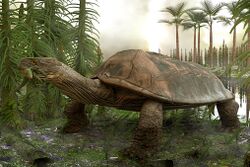Biology:Carbonemys
| Carbonemys | |
|---|---|

| |
| Life restoration of Carbonemys | |
| Scientific classification | |
| Domain: | Eukaryota |
| Kingdom: | Animalia |
| Phylum: | Chordata |
| Class: | Reptilia |
| Order: | Testudines |
| Suborder: | Pleurodira |
| Family: | Podocnemididae |
| Genus: | †Carbonemys Cadena et al., 2012 |
| Type species | |
| †Carbonemys cofrinii Cadena et al., 2012
| |
Carbonemys cofrinii is an extinct giant podocnemidid turtle known from the Middle Paleocene Cerrejón Formation of the Cesar-Ranchería Basin in northeastern Colombia. The formation is dated at around 60 to 57 million years ago, starting at about five million years after the KT extinction event.[1]
Discovery
In 2005, the holotype specimen was discovered in the Cerrejón coal mine by a North Carolina State University doctoral student named Edwin Cadena. It had a shell that measured about 1.72 metres (5 ft 8 in) and estimated at 1.8 metres (5 ft 11 in) for complete carapace,[1] making it one of the world's largest turtles.[2][3]
Paleobiology
Carbonemys’ relatively massive jaws[1] indicate that it had a powerful bite. It was likely an omnivore, consuming plants and mollusks as well as smaller reptiles, which were diverse and abundant in its neotropical freshwater habitat.[4][5] Its cohabitants included other turtles like the smaller podocnemid Cerrejonemys, the giant boid (constrictor) Titanoboa, and crocodylomorphs such as the dyrosaurids Cerrejonisuchus, Acherontisuchus, and Anthracosuchus.
References
- ↑ 1.0 1.1 1.2 Cadena, E. A.; Ksepka, D. T.; Jaramillo, C. A.; Bloch, J. I. (2012). "New pelomedusoid turtles from the late Palaeocene Cerrejón Formation of Colombia and their implications for phylogeny and body size evolution". Journal of Systematic Palaeontology 10 (2): 313–331. doi:10.1080/14772019.2011.569031. https://www.researchgate.net/publication/233777134_New_pelomedusoid_turtles_from_the_late_Palaeocene_Cerrejon_Formation_of_Colombia_and_their_implications_for_phylogeny_and_body_size_evolution.
- ↑ "Researchers reveal ancient giant turtle fossil". 17 May 2012. http://phys.org/news/2012-05-reveal-ancient-giant-turtle-fossil.html.
- ↑ Maugh II, Thomas H. (18 May 2012). "Researchers find fossil of a turtle that was size of a Smart car". LA Times. https://www.latimes.com/science/la-xpm-2012-may-18-la-sci-sn-largest-turtle-20120518-story.html.
- ↑ "Car-sized Turtle Found in Colombian Coal Mine : Discovery News". News.discovery.com. 2012-05-18. http://news.discovery.com/animals/car-sized-turtle-found-in-colombian-coal-mine.html.
- ↑ Freeman, David (17 May 2012). "Turtle Fossil Found In Colombia Suggests Carbonemys Cofrinii Was Size Of Small Car". Huffington Post. https://www.huffpost.com/entry/turtle-fossil-colombia-carbonems-confrinii-car_n_1524960.
Wikidata ☰ Q144470 entry
 |
